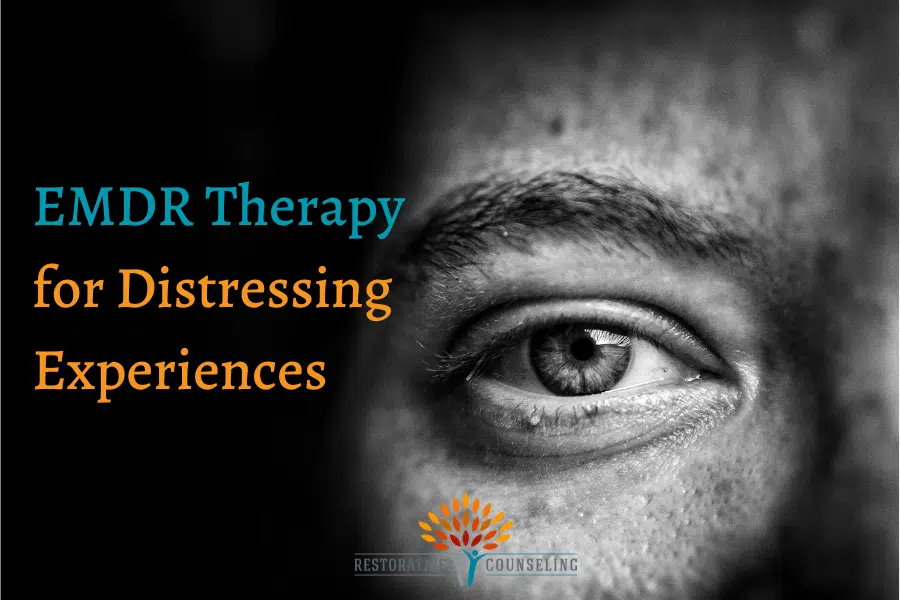Written by Jordan Meehan, LCSW
Eye Movement Desensitization and Reprocessing, or EMDR therapy, has become a trending topic in both the therapy world, as well as in the media. You may have heard about celebrities and well-known public figures sharing their experiences with EMDR. Despite EMDR starting to become more widely talked about, the treatment method has been around since the late 1980’s. Multiple national and international organizations recognize this therapeutic approach as an effective treatment for trauma, and it is gaining traction as an effective method for treating other mental health conditions as well.*
Trauma and EMDR Therapy
Often, people assume that trauma is associated with the development of Post-Traumatic Stress Disorder (PTSD). However, experiencing a traumatic or distressing event does not automatically mean that a person will develop PTSD. Traumatic experiences can lead to the development of anxiety disorders, depressive disorders, somatic (physical) disorders, and in some cases, personality disorders.
Some commonly known traumatic experiences include sexual assault, physical abuse, violent crime, a serious car accident, school shooting, etc. These all fall into what is considered the “Big T” trauma category.
In contrast, “Little t” traumas can be any distressing event or experience that leaves a lasting emotional and/or physiological impact on a person. To one person, an event may seem distressing, but not traumatic. But to another person, that same event may be traumatic in nature. Ultimately, the classification of an experience as traumatic is dependent on the person experiencing the event.
While there are many treatments available to treat mental health conditions that result from trauma, EMDR is one of the most successful and efficient evidence-based approaches. EMDR can help people become “unstuck” from difficult feelings, thoughts, and physical sensations related to their past distressing experiences.
Get started on your healing journey with EMDR therapy today
Phases of EMDR Therapy
EMDR is unique in that it does not involve much talking between the therapist and client. The therapist’s role in EMDR is to be a tool, rather than an interpreter of information, as is the case with more traditional talk therapies. EMDR is broken up into 8 phases:*
1. Client History
During this phase, the therapist collects information about the person’s symptoms, experiences, and triggers to help determine if the person is a good candidate for EMDR. They may utilize some assessments to understand the full extent of an individual’s symptoms. Additionally, the therapist works together with the individual to identify “targets” — specific memories — that are related to their present difficulties.
2. Preparation
At this point, the therapist explains the basic theory of EMDR and exposes the individual to some of what they can expect during the EMDR process. Then, the therapist demonstrates how Dual Attention Stimulus (DAS) will be used. The DAS options available depend on if EMDR is being conducted in-person or virtually, and depend on the preferences and needs of the person as well. The most common methods of DAS are back-and-forth eye movements and “butterfly” tapping (crossed arms over chest with alternating taps on each shoulder). during this phase, the therapist will teach several coping and grounding exercises as well.
3. Assessment
During the Assessment phase, the therapist and individual will work together to identify a specific target image. Then, the therapist assesses the individual’s current level of distress on a scale of 0 to 10 related to the image. Additionally, the individual identifies both the negative belief and a replacement positive belief they wish to have as it relates to the target memory.
4. Desensitization
This is the phase that most people think of when they hear about EMDR. During this phase, a DAS method is used to help the person reduce their distress related to the target image/memory. Once a person’s distress level has reached 0, then the therapist guides them through the Installation phase.
5. Installation
At this point in the process, the therapist encourages the individual to focus on the target image while thinking about the replacement positive belief they identified in the Assessment phase. The individual completes additional eye movements or tapping.
6. Body Scan
Once the Installation phase is complete, the therapist guides the person through a Body Scan exercise to help identify any lingering tension or tightness in the body.
7. Closure
The Closure phase involves the therapist reminding the individual about what they can expect following an EMDR session. They are encouraged to continue using their grounding and coping strategies, and to write down the things they notice in the days following a session.
8. Re-evaluation
The therapist will check in with the individual during the next session to assess their distress level related to the original target image/memory. Additional target images may be identified for the individual to work through using the EMDR process again.
EMDR can be used as a standalone treatment method, or it can be used in combination with other therapies, depending on the needs of the person receiving care. While this psychotherapy can be very beneficial, it is not intended to be used for all issues or with every person. Working with a skilled EMDR therapist is key to getting the most benefit out of your EMDR experience.
For more information about EMDR therapy, visit:
Traumatic experiences can be difficult to overcome. Restorative Counseling can help!
Going through traumatic experiences can leave you feeling trapped by your own emotions. EMDR is a helpful way to get you back to living your life, free from distressing emotions and physical sensations. Schedule an appointment today to start your process of healing.
*References:
EMDR International Association. (2022, August 17). Retrieved August 18, 2022, from https://www.emdria.org/
Shapiro, F. (2001). Eye Movement Desensitization and Reprocessing, 2nd edition, N.Y.: The Guilford Press.

Hi, I’m Jordan!
I partner with teens and adults to treat concerns related to trauma, anxiety, and relationships utilizing CBT, ACT, and EMDR approaches. Read more about me.
Follow Restorative Counseling
Sign up for our newsletter

